 Karmann Ghia is 60 years old…..When Wheel Tracks learned that 2013 was the Volkswagen Karmann Ghia’s 60th anniversary we thought it was a good idea to feature the car for our May issue. We asked club members for input and maybe even some stories about their Karmann Ghia’s they presently own or have owned in the past. The results was a surprise. There are only two listed in our VAE Roster and that appears to be it. WT has heard of a number of VW Beetle stories but we assume no other members own or have owned a Karmann Ghia. Our front page Ghia is owned by Ken Taplin of Blue Hill, Maine. The second Ghia, pictured to the right, is owned by your editor in Enosburg, Vermont, a 1968 Coupe.
Karmann Ghia is 60 years old…..When Wheel Tracks learned that 2013 was the Volkswagen Karmann Ghia’s 60th anniversary we thought it was a good idea to feature the car for our May issue. We asked club members for input and maybe even some stories about their Karmann Ghia’s they presently own or have owned in the past. The results was a surprise. There are only two listed in our VAE Roster and that appears to be it. WT has heard of a number of VW Beetle stories but we assume no other members own or have owned a Karmann Ghia. Our front page Ghia is owned by Ken Taplin of Blue Hill, Maine. The second Ghia, pictured to the right, is owned by your editor in Enosburg, Vermont, a 1968 Coupe.
Ken has owned his convertible for only a few years since he purchased it at the annual “Owl’s Head Transportation” auction in Maine. He had an older Ghia when he moved to Maine in 1967 and that spurred him to bid on one of the three that were in the auction. He has 25 antique and classic cars and drives most of them. If you check the roster you will see he is partial to air-cooled cars, his latest is a 356A Porsche coupe. He drove the Ghia to our 2011 Stowe Show where the front page photo originated, that is Ken pictured with the car.
From Ken…” I saw Wheel Tracks mentioned the ’46 Beetle I had in college. One of the many cars I should have kept, with it’s mechanical brakes and semaphore turn signals but you can’t keep them all. Another one I let go was a ’27 Minerva limo. I did keep the first two cars I owned, a’31 American Austin coupe and a ’29 Franklin 4dr”.
Here is some history from Ronan Glon…. Volkswagen is celebrating the 60th anniversary of the Karmann Ghia. Nicknamed the Beetle in a sport coat, the car was previewed by a close-to-production concept that debuted at the 1953 edition of the Paris Motor Show. The Ghia came to life when coachbuilder Karmann asked Ghia designer Luigi Segre to draw a new body for the Beetle. Operating with-out input from Volkswagen, Karmann believed there was a market for a sleek and sporty convertible based on the cheap and readily available Beetle chassis.
For reasons that remain unknown, the convertible body style was scrapped and the first prototype took the form of a coupe. Segre presented the car to Karmann execs in a small Parisian garage in October of 1953 and although it was not the ragtop the men had imagined, they were thrilled with the result and proudly presented it at the show. The Ghia was generally well-received by the press and by visitors.
Volkswagen chief Heinz Nordhoff examined the car inside and out shortly after the show. He was impressed with what the Beetle had spawned, but he feared the coupe would be too expensive to mass-produce. Karmann proposed to build the coupe alongside the Beetle convertible in its own factory and the Ghia was quickly given the green light for production. The Karmann Ghia was launched across Europe in early 1955 after undergoing only minor changes in its transition from a show car to a production vehicle. It was powered by a rear-mounted 1.2-liter air-cooled flat-four lifted straight from the Beetle parts bin. The convertible that Karmann had initially en-visioned was finally added to the Volkswagen lineup in 1957. Positioned above the iconic Beetle, the Ghia enabled Volkswagen to reach a trendier target audience while boosting its image across Europe and on the ever-important United States market.
The Karmann Ghia was phased out in 1974 after 362,601 coupes and 80,881 convertibles were built. The prototype that debuted in Paris is part of a private collection but it is occasionally displayed at Volkswagen events throughout Europe.
I was heading South on the Jersey Turnpike in the early 60s when it happened.
It was maybe 2AM Monday morning and I am driving my 57 Pontiac Star Chief a little faster than the speed limit…. Mine is practically the only car on the road, I am heading back to my ship at the naval base in Norfolk, VA. As usual I am using 110% of a three day weekend at home in Vermont. The Star Chief could cruise forever at ninety mph, at least empty…. Going home on Friday I had a 500 pound load of potatoes in the back seat area so I had to go slower. My Navy pay was only $76 a month back then, so I bought fresh picked potatoes in Virginia and sold them in Vermont where the new crop would not be ready for another month. The profit from the potatoes paid for my gas and tolls and I had $50 left for the weekend.
Back to that night on the turnpike. There had been no lights in my rearview mirror for some time when I noticed lights slowly gaining on me from a long way back. I slowed down a bit but knowing the cops didn’t bother you much that late at night I didn’t slow a lot. It was not long when the vehicle behind me pulled into the fast lane and slowly passed me on the left. It was not a cop or an ambulance; it was a VW Karmann Ghia. I was able to talk to the gent in the Ghia a ways down the pike at a truck stop and found the little car had only it’s original 40 hp engine! I vowed that someday I would have a Karmann Ghia.
Jumping ahead a few years, it is now 1971. I am out of the navy and back in Vermont working electronics for a local cable TV company, I am married and have two lovely young daughters. I am minding my business one day while driving by Smiley’s used car lot in Georgia,VT when I spot a robins egg blue Karmann Ghia. It was a 68 coupe fresh from a 4X4 trade with an Air Force gent being transferred to St. Albans, he had bought it new in Mississippi and needed something the he could drive in our winters. You can guess the rest, Smiley and I made the $700 deal and I drove it home a few days later.
You had to sit slightly sideways with your feet to the right and the tiny foot pedals made for some tricky foot-work but it was fun to drive. The only problem was when I got on the interstate I could only get maybe 70MPH out of her and there was no more. That is when I determined I needed to get rid of the automatic transmission and the AC. With only 44 HP to start with there was not much left for the rear wheels to use. A transplanted standard shift and nixing the AC did the job…95 to 100Mph was now reachable alt-hough I was, by then, a responsible married guy and I didn’t do high speeds any longer….. well, not as often.
Again, jumping ahead to 2014… (life sure has a lot of ‘jumps’). My Karmann Ghia is parked out in the barn patiently waiting for me to get over my obsession with cars from the 1920s so it can get back on the road again. It was my main driver for 12 years and a lot of nice adventures happened during that time.
How many of you are thinking about my possible mistake of getting rid of the automatic transmission and the AC? The part you are missing is the 12 years that I drove it with all of those 44 horses. That is the part that makes my decision all-right!
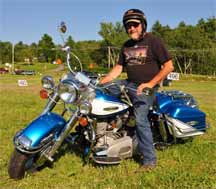 Mark McDermiott is pictured right at the 2014 VAE Car Show in Stowe on his 1967 Harley Electra Glide. He has had his Harley for 20 years and in that time has rebuilt and restored about every part on it.
Mark McDermiott is pictured right at the 2014 VAE Car Show in Stowe on his 1967 Harley Electra Glide. He has had his Harley for 20 years and in that time has rebuilt and restored about every part on it.









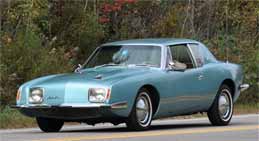 Ray and Julies’s ‘64 Studebaker Avanti R2 has been sold to someone in the state of Washington.
Ray and Julies’s ‘64 Studebaker Avanti R2 has been sold to someone in the state of Washington.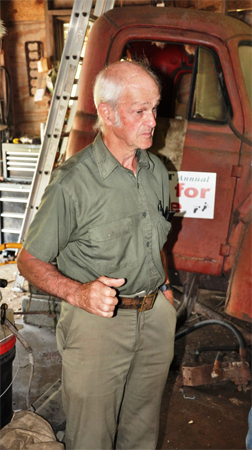 What do we do when we decide it is time to downsize our collection? How do we even get started? We might decide we want to move where the snow doesn’t fly or that we simply want less to deal with. What ever the reason, the collection that seemed to have accumulated very easily and some might say ‘over-night’ can be a very daunting task when you are looking to scale down.
What do we do when we decide it is time to downsize our collection? How do we even get started? We might decide we want to move where the snow doesn’t fly or that we simply want less to deal with. What ever the reason, the collection that seemed to have accumulated very easily and some might say ‘over-night’ can be a very daunting task when you are looking to scale down.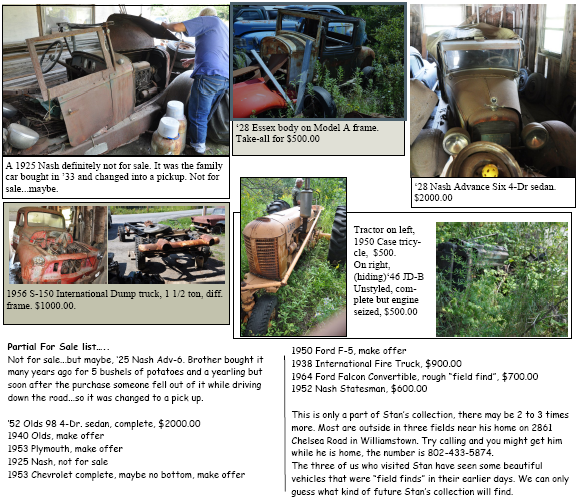
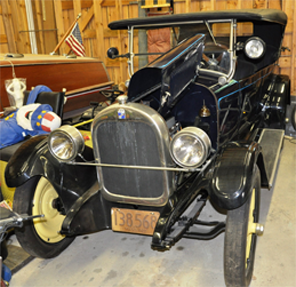 You are looking at the lonely life of Pierre Pepin’s beautiful Blue 1922 Durant touring car. Pierre purchased the car a few years ago at the Stowe Car Show in the car corral. He traded a model A, or was that two, plus a little too-boot. He is a little sad that he has never had it on the road even though it appears to be ready to roll down the highway any time you ask. Pierre’s Durant made it’s way from New Jersey in 1997 to East Chelmsford, Massachusetts. From there to Stowe and then it’s present very quiet life in Colchester.
You are looking at the lonely life of Pierre Pepin’s beautiful Blue 1922 Durant touring car. Pierre purchased the car a few years ago at the Stowe Car Show in the car corral. He traded a model A, or was that two, plus a little too-boot. He is a little sad that he has never had it on the road even though it appears to be ready to roll down the highway any time you ask. Pierre’s Durant made it’s way from New Jersey in 1997 to East Chelmsford, Massachusetts. From there to Stowe and then it’s present very quiet life in Colchester.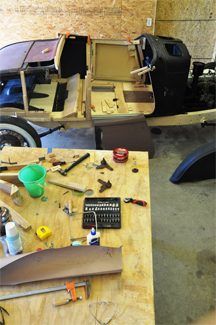 Ken Squier’s Plymouth came to him in parts and had spent many years in the garage of former owner Stewart Raydell of Williamstown, VT. Ken is very fast to say that he has had very little to do with working on the project. His step son-in-law, Sandy Thompson, has taken on all the wood related work between his obligations at his business building staircases and handrails at his company in Stowe. Most of the wood is ash and it appears Sandy has done a better job than the 1932 factory workers. The mechanical work is being done by Gary Scott of East Barre.
Ken Squier’s Plymouth came to him in parts and had spent many years in the garage of former owner Stewart Raydell of Williamstown, VT. Ken is very fast to say that he has had very little to do with working on the project. His step son-in-law, Sandy Thompson, has taken on all the wood related work between his obligations at his business building staircases and handrails at his company in Stowe. Most of the wood is ash and it appears Sandy has done a better job than the 1932 factory workers. The mechanical work is being done by Gary Scott of East Barre. 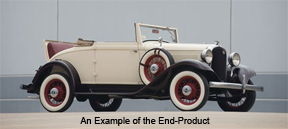 Gary has his own garage business and has a long history of working on Ken’s projects. Mr. Raydell’s neighbor, Steve Stephenson, remembers the car and told Wheel Tracks that he was the person who rebuilt the engine some 15 years age. At one time not too long ago there was a plan to have the car completed for the 2014 Stowe Car Meet this August but they all agree it might now be the 2015 meet instead. They have a ways to go yet.
Gary has his own garage business and has a long history of working on Ken’s projects. Mr. Raydell’s neighbor, Steve Stephenson, remembers the car and told Wheel Tracks that he was the person who rebuilt the engine some 15 years age. At one time not too long ago there was a plan to have the car completed for the 2014 Stowe Car Meet this August but they all agree it might now be the 2015 meet instead. They have a ways to go yet.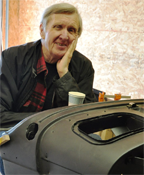 Ken Squier has a ‘bit’ of a history of being around cars and got started when he was 12 announcing sport events on his dad’s Waterbury radio station, WDEV. He was well known for his skill announcing live play-by-play dirt track races in Vermont during his younger years. His early Vermont announcing booth was an old logging truck. In fact he became so involved that he was able to convince NASCAR and CBS to get together and then basically created an announcing job for himself with CBS for many years.
Ken Squier has a ‘bit’ of a history of being around cars and got started when he was 12 announcing sport events on his dad’s Waterbury radio station, WDEV. He was well known for his skill announcing live play-by-play dirt track races in Vermont during his younger years. His early Vermont announcing booth was an old logging truck. In fact he became so involved that he was able to convince NASCAR and CBS to get together and then basically created an announcing job for himself with CBS for many years.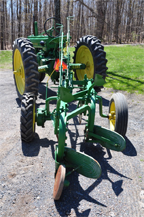 The family farm where I grew up in Milton had two tractors, a 1942 John Deere B and a 1929 Farmall F20. The F20 had steel wheels but was later converted to rubber tires making for a smoother ride and easier for the town road crews. I couldn’t wait to drive these tractors and finally when I was nine my dad agreed to show me how. That led to many hours of plowing, harrowing, planting, haying, sugaring, manure spreading, etc. Later, in 1959 Dad purchased a JD 435D, John Deere’s first venture into a small diesel tractor. This tractor had an engine built by General Motors, was made for only two years and is very collectible. That year, 1959, was the year I graduated from high school and left the farm eventually forming my own construction company where I still work.
The family farm where I grew up in Milton had two tractors, a 1942 John Deere B and a 1929 Farmall F20. The F20 had steel wheels but was later converted to rubber tires making for a smoother ride and easier for the town road crews. I couldn’t wait to drive these tractors and finally when I was nine my dad agreed to show me how. That led to many hours of plowing, harrowing, planting, haying, sugaring, manure spreading, etc. Later, in 1959 Dad purchased a JD 435D, John Deere’s first venture into a small diesel tractor. This tractor had an engine built by General Motors, was made for only two years and is very collectible. That year, 1959, was the year I graduated from high school and left the farm eventually forming my own construction company where I still work. Karmann Ghia is 60 years old…..When Wheel Tracks learned that 2013 was the Volkswagen Karmann Ghia’s 60th anniversary we thought it was a good idea to feature the car for our May issue. We asked club members for input and maybe even some stories about their Karmann Ghia’s they presently own or have owned in the past. The results was a surprise. There are only two listed in our VAE Roster and that appears to be it. WT has heard of a number of VW Beetle stories but we assume no other members own or have owned a Karmann Ghia. Our front page Ghia is owned by Ken Taplin of Blue Hill, Maine. The second Ghia, pictured to the right, is owned by your editor in Enosburg, Vermont, a 1968 Coupe.
Karmann Ghia is 60 years old…..When Wheel Tracks learned that 2013 was the Volkswagen Karmann Ghia’s 60th anniversary we thought it was a good idea to feature the car for our May issue. We asked club members for input and maybe even some stories about their Karmann Ghia’s they presently own or have owned in the past. The results was a surprise. There are only two listed in our VAE Roster and that appears to be it. WT has heard of a number of VW Beetle stories but we assume no other members own or have owned a Karmann Ghia. Our front page Ghia is owned by Ken Taplin of Blue Hill, Maine. The second Ghia, pictured to the right, is owned by your editor in Enosburg, Vermont, a 1968 Coupe.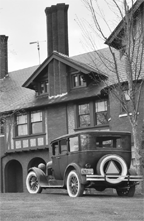 A comment on a VAE tour… “I could hear you and your ‘clutch’ behind me”
A comment on a VAE tour… “I could hear you and your ‘clutch’ behind me”
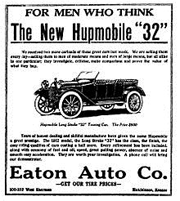 Editor’s notes… Robert Craig Hupp, a former employee of Oldsmobile and Ford, found-ed the company with his brother Louis Gorham Hupp in 1908. Production began in 1909. Following disagreements with his financial backers Robert Hupp sold his stock in the Hupp Motor Car Company and established the short-lived RCH Automobile Company, later the Hupp-Yeats Electric Car Company. In 1912, Hupp would be one of two automakers pioneering the use of all-steel bodies. Hupp Motor Company continued to grow after its founder left. A new plant was purchased in 1924 as Hupp competed strongly against Ford and Chevrolet. DuBois Young became company president in 1924 moving up from vice-president of manufacturing. By 1928 sales had reached over 65,000 units. To increase production and handle the growth in sales, Hupp purchased the Chandler-Cleveland Motors Corporation (Chandler Motor Car) for its manufacturing facilities. Sales and production began to fall even before the onset of the depression in 1930. A strategy to make the Hupmobile a larger, more expensive car began with the 1925 introduction of an 8-cylinder model, followed by the discontinuance of the traditional 4-cylinder Hupmobile. While aiming for a seemingly more lucrative market segment, Hupp essentially turned its back on its established clientele. Unfortunately, the company made the same mistake that many other medium-priced carmakers were making at the same time. Namely, in an attempt to capture every possible sale, they offered many different models. With Hupmobile’s relatively low production volume, the result was that no model could be produced in sufficient quantity to keep manufacturing costs low enough to provide an operating profit.
Editor’s notes… Robert Craig Hupp, a former employee of Oldsmobile and Ford, found-ed the company with his brother Louis Gorham Hupp in 1908. Production began in 1909. Following disagreements with his financial backers Robert Hupp sold his stock in the Hupp Motor Car Company and established the short-lived RCH Automobile Company, later the Hupp-Yeats Electric Car Company. In 1912, Hupp would be one of two automakers pioneering the use of all-steel bodies. Hupp Motor Company continued to grow after its founder left. A new plant was purchased in 1924 as Hupp competed strongly against Ford and Chevrolet. DuBois Young became company president in 1924 moving up from vice-president of manufacturing. By 1928 sales had reached over 65,000 units. To increase production and handle the growth in sales, Hupp purchased the Chandler-Cleveland Motors Corporation (Chandler Motor Car) for its manufacturing facilities. Sales and production began to fall even before the onset of the depression in 1930. A strategy to make the Hupmobile a larger, more expensive car began with the 1925 introduction of an 8-cylinder model, followed by the discontinuance of the traditional 4-cylinder Hupmobile. While aiming for a seemingly more lucrative market segment, Hupp essentially turned its back on its established clientele. Unfortunately, the company made the same mistake that many other medium-priced carmakers were making at the same time. Namely, in an attempt to capture every possible sale, they offered many different models. With Hupmobile’s relatively low production volume, the result was that no model could be produced in sufficient quantity to keep manufacturing costs low enough to provide an operating profit.